YouTube Private Video vs Unlisted: Complete Guide (2025)
- Key Differences Between Public, Private, and Unlisted Videos
- How To Make a Private or Unlisted YouTube Video
- How To Change Your Video Privacy Settings
- How To Find Unlisted YouTube Videos or Playlists Without a Link
- How To Find Hidden Unlisted Videos on Your Channel
- How To Fix Common Private Video Issues
- FAQs on YouTube Unlisted vs Private Videos
- YouTube Unlisted vs Private: Which One to Use?
YouTube is the go-to platform for everything from sharing your latest video project to uploading funny cat videos. But not every video is meant for the public eye. Whether you're sharing personal content or working on something behind the scenes, adjusting your video's privacy settings can give you more control over who sees it.
How do I choose the right privacy settings for a YouTube video? It all depends on your audience. YouTube offers three main privacy options: public, private, and unlisted. With over 33% of the global population using YouTube each month (Flybynightgraphics, 2025)¹, deciding how widely you want to share your content is an important step.
In this guide, I’ll show you how to make your YouTube videos unlisted or private and explain the key differences between these settings. We’ll also look at whether it’s possible to find unlisted videos or playlists without a direct link. Let’s dive in.
Key Differences Between Public, Private, and Unlisted Videos
Let's break down all the YouTube video types to see how they differ and why it matters for your videos.
Public Videos
A public video is visible to everyone. It appears in search results, can be recommended by the algorithm, and anyone can watch, comment, like, and share it. Use this setting for content meant for wide distribution or monetization.
Pros:
- Broader audience reach. Public videos are visible to everyone, expanding your content’s reach to a global audience.
- Improved discoverability. These videos appear in YouTube search results, recommendations, and even Google searches, helping you increase visibility and grow your channel.
- Monetization potential. Public videos can be monetized through ads, brand partnerships, and other YouTube features.
- Global feedback. A larger audience means more feedback, which can help improve content or provide insights for your business.
- Social sharing. Viewers can easily share your content across social media and other platforms, potentially leading to viral growth.
Cons:
- Limited control over the audience. Public videos are accessible to anyone (unless restricted by age or country), leaving you with no control over who views or shares them.
- Privacy concerns. If your content is too personal or confidential, it’s at risk of being exposed to a broad audience or even attracting trolls or negative comments.
- Permanent visibility. Once a video is public, it can be found by anyone and may continue circulating even after deletion.
- Impact on job opportunities. Inappropriate or controversial content could negatively affect future job prospects, as recruiters often review candidates’ online profiles.
Private Videos
Private videos are visible only to you and those you invite by email. They won’t appear in search results or on your channel and can only be viewed by invited viewers signed into a linked Google account.
Pros:
- Maximum privacy control. Only people you invite via email can view private videos, making them the most secure option for sensitive content.
- Ideal for personal use. Perfect for secure sharing of personal content like family videos or for keeping a personal collection of media.
- Business or team use. You can securely store and share business materials, training videos, or strategy sessions with a specific group (e.g., team members or stakeholders).
- No public interaction. Can I comment on a private YouTube video? You can’t; comments are turned off by default. If you'd like to allow them without making the video public, consider switching the setting to unlisted.
- Frees up device storage. Can I use private video as a backup solution? Absolutely. By uploading videos to YouTube and keeping them private, you can free up space on your device without losing access to your files.
Cons:
- Limited audience. The video is completely restricted to those you invite, which means there is no potential for discovery beyond your personal circle.
- No public exposure. You cannot gain public exposure, feedback, or monetization opportunities from private videos.
- Sharing complications. Sharing private videos can be cumbersome, as each viewer must be invited individually via email.
Users under 18 will have their videos set to private by default, and only those aged 18+ can change visibility settings to public or unlisted.
Unlisted Videos
Unlisted videos are not publicly searchable or visible on your channel, but anyone with the link can view and share them. Your unlisted videos stay hidden from YouTube's search results unless someone adds them to a public playlist. They’re ideal for semi-private sharing like portfolios, private tutorials, or internal company content.
Pros:
- Controlled access. Only those with the link can view the video — no Google account required, providing a level of privacy without fully restricting access.
- Pre-release feedback. You can share unlisted videos with a select group to gather feedback before making them public.
- Portfolio display. Ideal for sharing work samples, resumes, or private tutorials without exposing them to the general public.
- Website integration. You can embed unlisted videos on your website, blogs, or social media posts, making them accessible to viewers without adding them to your channel.
- Organized channel. Unlisted videos keep your main YouTube channel focused on primary content while allowing secondary content to be easily accessed through direct links.
Cons:
- Link sharing is required. Access is open to anyone with the link, and there’s no way to restrict access to specific individuals (unlike private videos). That means your content could end up in the hands of unintended audiences.
- Not indexed by search engines. Unlisted videos are not searchable, recommended by YouTube’s algorithm, and don’t appear in subscriber feeds, which limits their organic discoverability.
- Not ideal for large audiences. If you’re looking to grow your channel or business, unlisted videos don’t offer the exposure or reach that public videos do.
- No direct monetization. They don’t contribute to the overall view count of the channel or the total watch hours needed for certain monetization thresholds, like joining the YouTube Partner Program.
YouTube Public, Unlisted, and Private Videos — Comparison Table
Understanding YouTube's video settings — public, unlisted, and private — is key to managing who sees your content. Here’s a quick comparison table that outlines the main features of each setting, helping you choose the right one for your video's visibility and audience reach:
| Feature | Public | Unlisted | Private |
| The video URL is shareable | ✅ | ✅ | ❌ (can only be shared with specific Google accounts) |
| Content appears on your YouTube channel | ✅ | ❌ | ❌ |
| Video can be added to a channel’s section | ✅ | ✅ | ❌ |
| Video appears in YouTube recommendations and search engines | ✅ | ❌ | ❌ |
| Video can be added to public playlists | ✅ | ✅ | ❌ |
| Video shows up in the subscriber feed | ✅ | ❌ | ❌ |
| Audience can comment | ✅ | ✅ | ❌ (only those with access can comment) |
| An account is needed to watch it | ❌ | ❌ | ✅ (Google account required) |
| Best for | Content creators, marketers, and educators who want to reach a broad audience, grow subscribers, or monetize content | Freelancers, educators, and businesses who want to share content without making it publicly discoverable (portfolios, onboarding videos) | Internal company use, personal archives, confidential content, or early access previews for a select group |
Editor's Note: Transparency is one of our core values at vpnMentor, so you should know we are in the same ownership group as ExpressVPN. However, this does not affect our review process.
How To Make a Private or Unlisted YouTube Video
Creating a private or unlisted video on YouTube is straightforward and can be done either at the time of upload or by changing the settings on an existing video. Here are the steps to follow when uploading a new video:
- Sign in. Open YouTube in the browser or app on your device and sign in to your YouTube account.
- Upload your video. In the upper right corner, click Create > Upload videos.
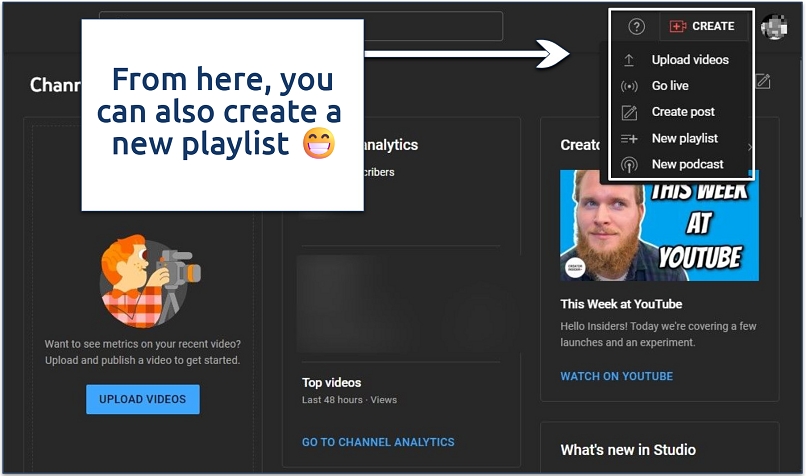 YouTube Studio will open automatically after you click Upload videos
YouTube Studio will open automatically after you click Upload videos - Enter the video details. Provide the title, description, and other information for your video.
- Change the visibility filter. Click the Visibility tab and choose Private or Unlisted.
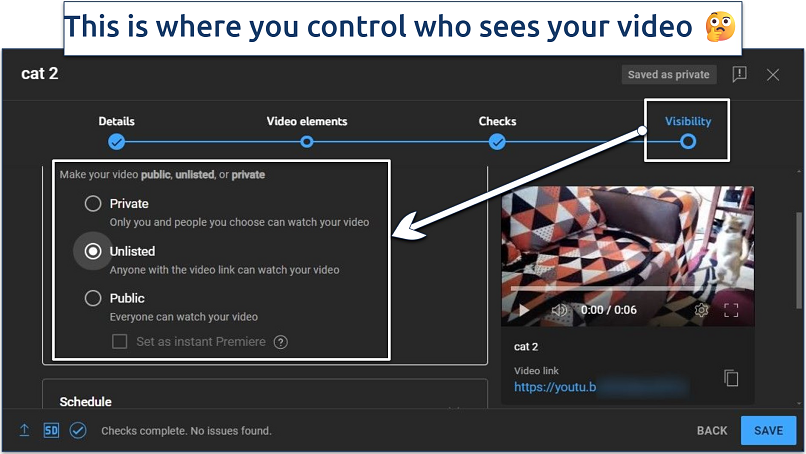 Click Save after choosing the right video privacy settings
Click Save after choosing the right video privacy settings
As a creator, you might want to use YouTube’s scheduling or premiere options. Scheduling lets you upload a video and set a future date and time for it to go live. When you premiere a video, a public watch page is created before it goes live, letting viewers set reminders and anticipate the release. Once the premiere begins, the video plays live like a livestream, with a chat for interacting with the audience.
How To Change Your Video Privacy Settings
Once a video is uploaded, you can easily adjust its visibility at any time. These settings give you flexible control over who can view your content without deleting or re-uploading anything.
- Log in to your YouTube account. Then, click on your profile icon and open the YouTube Studio.
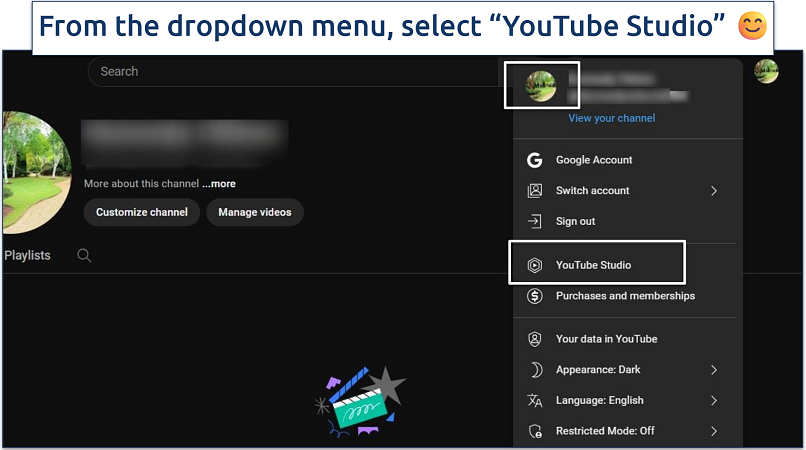 Finding unlisted videos on your channel is straightforward; the guide below breaks it down for you
Finding unlisted videos on your channel is straightforward; the guide below breaks it down for you - Navigate to the Content tab. It’s on the left sidebar.
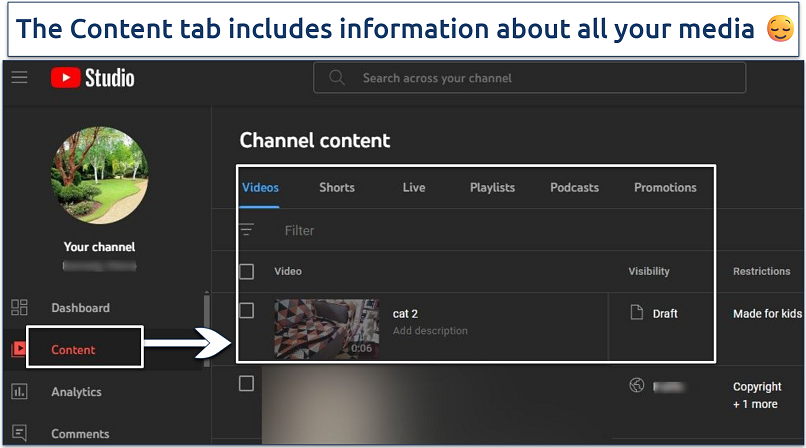 You must be signed in to your YouTube Studio account to change privacy settings
You must be signed in to your YouTube Studio account to change privacy settings - Click on the video you’d like to update. You can also use the pencil icon next to your video to edit.
- Look for the Visibility setting. From here, you can switch between public, private, or unlisted.
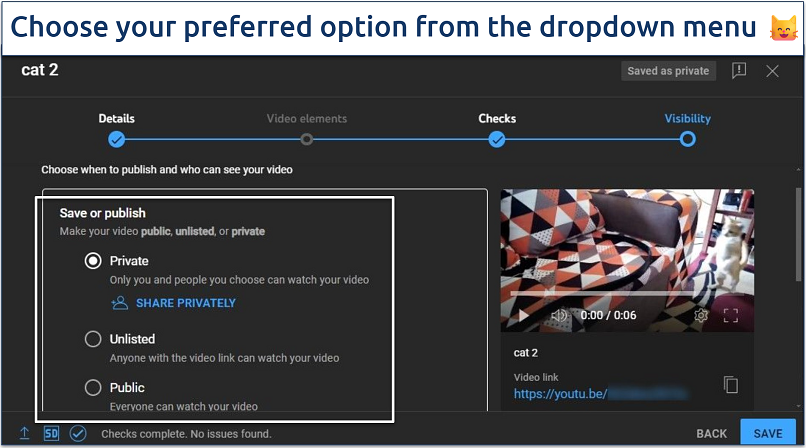 From here, you can add people who can view your private video
From here, you can add people who can view your private video - Save your changes. That’s it.
How To Find Unlisted YouTube Videos or Playlists Without a Link
There are legitimate reasons for searching for unlisted YouTube videos without a direct link, particularly in scenarios where the intended audience needs to regain access. For instance, students or employees might need to retrieve educational or training content that was previously shared with them but for which they've lost the link.
Additionally, researchers or journalists could require access to unlisted videos that are relevant to their work, provided their methods of access comply with legal and ethical standards. In such situations, consider the following methods:
Using Third-Party Websites
Platforms like Unlisted Videos allow for searching and submitting unlisted YouTube videos for others to watch. You can access a vast collection of unlisted videos, but they're only random and may not be helpful if you're looking for a specific video. However, keep in mind that such unofficial sites might not have robust security measures, potentially exposing users to risks. Sharing unlisted videos without the uploader's consent might also infringe on copyright laws.
Note: In July 2021, YouTube implemented a change where all unlisted videos uploaded before 2017 were made private unless the uploader opted out of this change. This action was part of an effort to improve the security of unlisted videos, which were previously found to be more susceptible to being discovered and shared without the uploader's consent due to an older, less secure unlisted video link system.
This change resulted in a significant reduction in the number of available unlisted YouTube videos from that period. Still, the Unlisted Videos website includes many from 2016 and earlier.
Using Search Operators on Google
Search operators are special commands that help fine-tune search results and find specific content on Google. You can find unlisted videos in your search category by using specific search queries such as site:youtube.com intext:unlisted(followed by your keyword). Alternatively, searching the specific unlisted video title in square brackets, for example, site:youtube.com [pewdiepie unlisted] can help refine results.
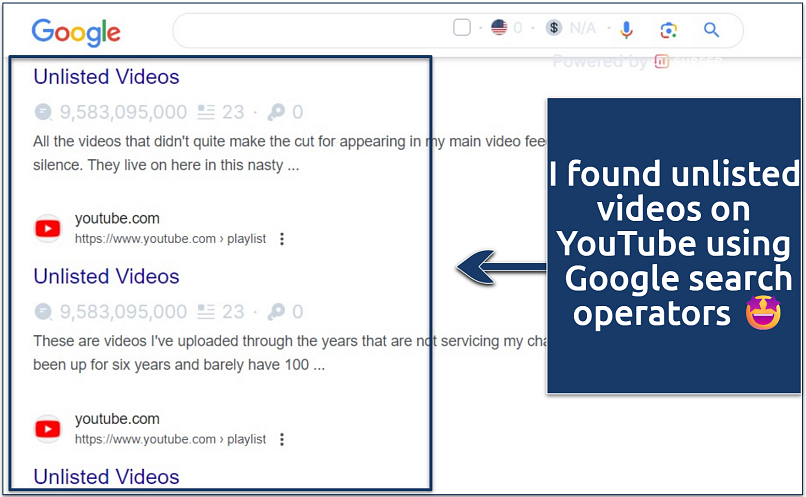 You can customize search operators to help you find unlisted videos on your favorite YouTube channel
You can customize search operators to help you find unlisted videos on your favorite YouTube channel
Public YouTube Playlists
If an unlisted video is added to a public playlist, it becomes discoverable to anyone who views the playlist. However, finding such playlists can be challenging unless you know what you're looking for, as unlisted videos don’t appear in YouTube’s search results or related video recommendations.
Pro Tip: While videos set to unlisted generally don't appear in search results, subscriber feeds, or YouTube suggestions, anyone with the link can still watch them. It's important to know that there are ways for curious individuals or even hackers to find and use this link without your permission. Learn how to keep your unlisted videos more secure.
It’s also a good idea to follow these general rules:
- Keep the link private and avoid posting it on social media or any public platforms.
- Think about setting up a private YouTube channel or playlist for an extra layer of privacy.
- Periodically check and manage who can view your unlisted videos.
- If you think the link might have gotten into the wrong hands, switch the video to private or delete it and upload it again with a new link to regain control.
How To Find Hidden Unlisted Videos on Your Channel
Unlisted videos on YouTube don’t appear in search results, on your channel page, or in subscriber feeds, which makes them difficult to locate without direct links. However, if you're the owner of the channel, you can easily find all your unlisted content through YouTube Studio.
- Go to YouTube Studio. Click on your profile icon in the top right corner and select YouTube Studio from the drop-down menu.
- Navigate to the Content section from the left-hand menu. This will take you to a page showcasing all the videos you’ve uploaded.
- Use the filter tool at the top to sort by visibility. Selecting Unlisted will reveal all your videos with that setting.
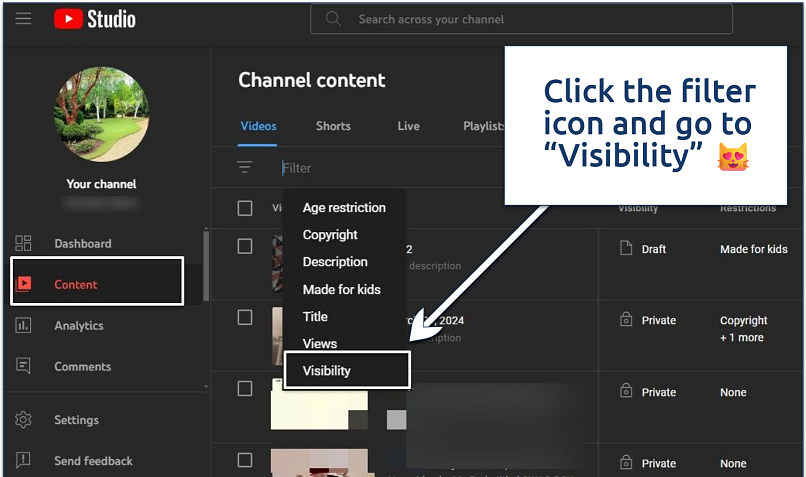 This option lets you filter out specific videos
This option lets you filter out specific videos - Manage unlisted videos. All unlisted videos will appear, and you can edit them from there.
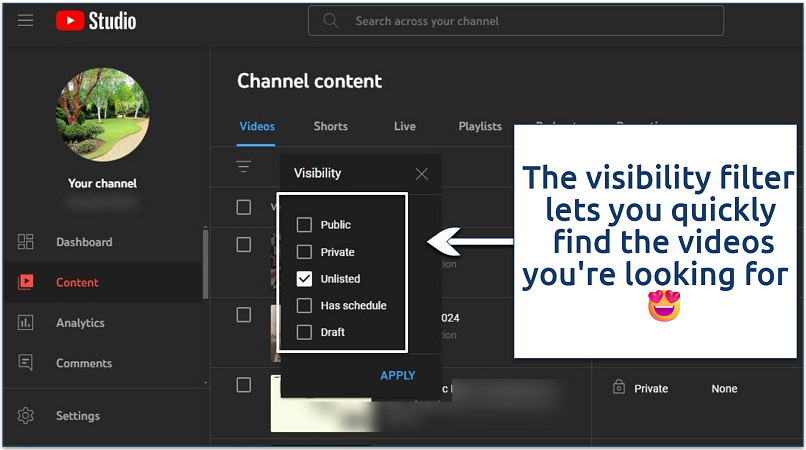 Click on any video to view or edit its details
Click on any video to view or edit its details
How To Fix Common Private Video Issues
Private videos offer greater control over who can view your content, but they can also cause a few headaches — for both creators and viewers. Below are common issues you might run into, along with quick ways to sort them out.
Invited Viewers Can’t Access the Video
If someone you've invited can't access one or more videos, chances are they’re not signed in with the right Google account. Private videos only work for the exact email you sent the invite to.
To troubleshoot, start by double-checking the email address you entered when sending the invite — even a small typo can prevent the viewer from receiving it.
If everything looks good but they’re still having trouble, resend the invitation to ensure that the viewer is properly granted access.
Video Not Showing in Playlist
Private videos are only visible to the people you’ve invited, and that restriction extends to playlists too. They won’t appear in any playlist that’s publicly visible.
To fix it, check the playlist’s privacy settings. If you want others to see the video in a playlist, the video itself needs to be unlisted or public. The playlist and video must have compatible visibility settings to appear together.
Video Not Appearing on Your Channel
Private videos won’t show up on your channel’s homepage or video tab, just as they should. They’re hidden from everyone except the people you’ve invited.
To make them visible on your channel, update the privacy setting to unlisted or public.
FAQs on YouTube Unlisted vs Private Videos
How can I watch a private video on YouTube?
You can only watch a private YouTube video if the uploader has granted access to your Google account. Without that permission, the video remains inaccessible, even if you have the link. Still, private videos pack some great perks for you and your business.
How do I create a private playlist on YouTube?
To start, sign in to your YouTube account and navigate to any video you want to add to a new playlist. Click the Save button below the video, then choose Create a New playlist. When prompted to name your playlist, choose Private in the visibility settings to ensure only you can access it. It's that easy, much like creating a private YouTube video.
You can also manage your playlists through your Library. Simply go to your Library, find the playlist, and click the three-dot menu or pencil icon to edit it. You can adjust the visibility at any time, switching from public or unlisted to private. Even if public or unlisted videos are added to a private playlist, the playlist remains private unless its visibility is changed.
Can I get a YouTube copyright claim on an unlisted video?
Yes, an unlisted video can receive a copyright claim. YouTube's automated system scans all videos for copyright violations. Although they offer some control over visibility, anyone with the link can view them — and even report content that infringes on copyright. Therefore, avoid sharing third-party content without the owner’s permission.
Can I embed private or unlisted YouTube videos on my website?
You can’t embed private videos, but you can easily do so with unlisted ones. Simply go to your unlisted video on YouTube, click Share, hit Embed, and copy the HTML code. Then, paste it into the HTML of your website or blog where you want the video to appear. Unlisted videos are not only easy to embed but also come with extra benefits for anyone, such as freelancers and educators, looking to share content with a select audience.
How do I share private or unlisted videos?
Sharing a private or unlisted video depends on the level of access you want to grant. For unlisted videos, simply share the unique link, and anyone with it can view the video without needing an account. Private videos, on the other hand, require you to invite specific people by email, and they must sign in with a Google account to watch. You can easily update the privacy settings to either private or unlisted even after the video is uploaded.
What’s the storage limit for private videos on YouTube?
There’s no specific limit for private videos, but you must adhere to YouTube’s storage and upload policies — each video can be up to 256 GB or 12 hours long, whichever comes first. This means you can upload as many private videos as you like within these limits. That makes YouTube a great choice for privately storing large videos without needing extra storage services.
However, keep in mind that the platform is built for content sharing rather than long-term archiving, so there’s a risk that a policy change, account issues, or shifts in terms of service could affect your access down the line.
How do I fix the YouTube private video error?
Several factors could trigger this error when trying to watch a private YouTube video. Fortunately, there are solutions available. Most often, the issue is that the video hasn't been shared with your Google account.
YouTube Unlisted vs Private: Which One to Use?
In deciding between unlisted and private settings for your YouTube videos, the choice hinges on your specific needs for sharing and visibility. Unlisted videos are the best option if you want to share your content with a specific audience without making it publicly searchable. They provide a blend of privacy and accessibility, perfect for sharing content with a link.
On the other hand, if your priority is maximum privacy — for instance, for personal or sensitive content meant for a very limited audience — then the private setting is your best bet. Each option has its unique benefits, so consider your audience and the video’s purpose carefully before deciding.
References
- https://flybynightgraphics.com/article/youtube-statistics-for-2024-users-facts-more/4657?utm_source=chatgpt.com/
- https://variety.com/2022/digital/news/youtube-shorts-1-5-billion-monthly-users-1235294308/
Your online activity may be visible to the sites you visit
Your IP Address:
216.73.216.13
Your Location:
US, Ohio, Columbus
Your Internet Provider:
Some sites might use these details for advertising, analytics, or tracking your online preferences.
To protect your data from the websites you visit, one of the most effective steps is to hide your IP address, which can reveal your location, identity, and browsing habits. Using a virtual private network (VPN) masks your real IP by routing your internet traffic through a secure server, making it appear as though you're browsing from a different location. A VPN also encrypts your connection, keeping your data safe from surveillance and unauthorized access.
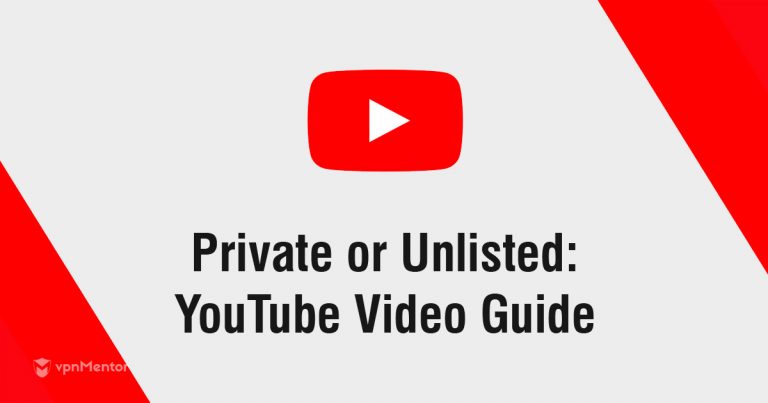



Please, comment on how to improve this article. Your feedback matters!